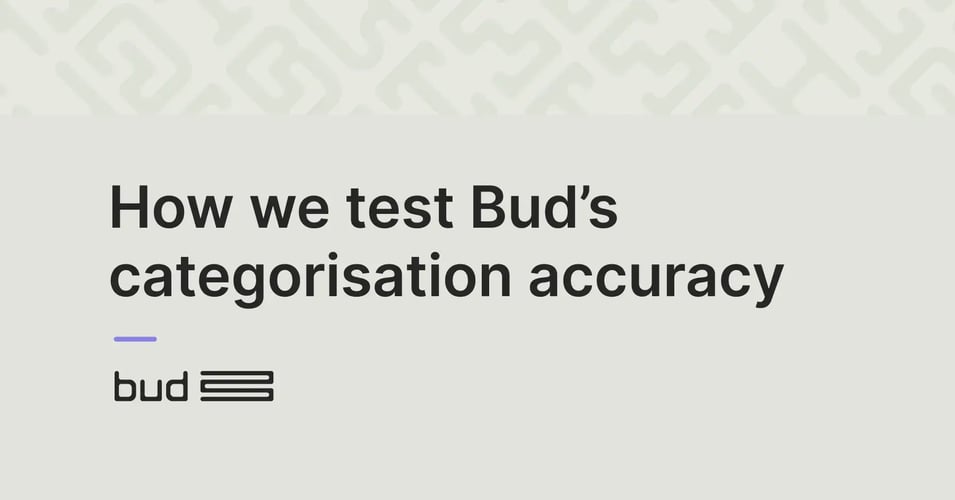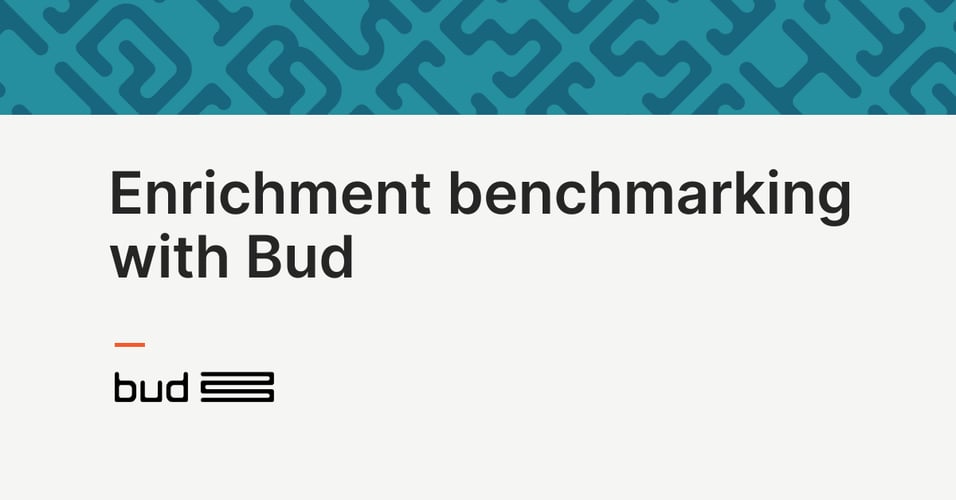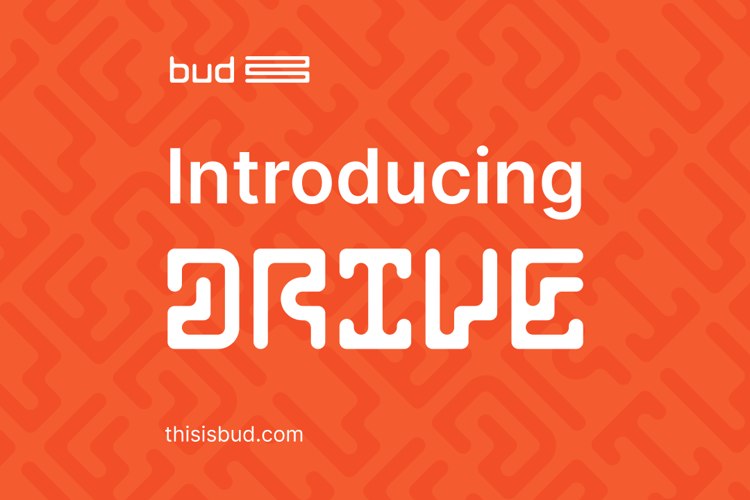As someone who buys digital technology, it’s important to know about the technical ins and outs of a solution before you decide to partner up.
Financial transaction categorisation is offered by many providers, but it's often just an add-on service, and rarely a core capability. Even providers focusing on categorisation, like open banking providers and money management tools, may fall short on top-quality enrichment.
That's because the accuracy and detail of AI-powered processing is crucial when it comes to transaction categorisation - with precise, granular results being required for maximum output and value. In some cases, these features are the difference between frustrating errors and a smooth categorisation experience (hello, satisfied customers).
Not all categorisation vendors are created equal, and there’s a reason why Bud’s transaction categorisation is market-leading. In this piece, you’ll get an overview of Bud versus industry standard transaction categorisation technology:
- What is Bud?
- Why is Bud’s transaction categorisation among the best?
- Granularity
- Accuracy
- Machine learning
- What does industry standard categorisation look like?
- Accurate categorisation underpins growth
- Summary: why Bud’s categorisation is market-leading
If you’re already familiar with Bud’s market-leading transaction categorisation, talk to us if you’d like to know more.
What is Bud?
Bud is a financial data intelligence provider using AI & ML to transform messy, raw financial data into digestible, actionable insights. Our data intelligence platform includes transaction categorisation and merchant identification, allowing our clients and their customers to better understand transactions.
Our platform adds context to transactional data, enabling banks to better understand their customers either by using Bud’s products or by feeding directly into their internal systems. This empowers lenders to make faster and more confident credit decisions as part of their affordability calculations and, in turn, enhances the customer experience and improves their financial habits.
At Bud, our products are powered by industry-leading AI that provides unparalleled insight into transactional data. By leveraging cutting-edge natural language processing and generative models, we can categorise and enrich data for even more value - allowing us to unlock hidden insights and new dimensions that were previously out of reach.
Why is Bud’s transaction categorisation among the best?
Because we recognise AI is only as powerful as the data it's trained on, Bud’s robust and powerful AI core ensures every transactional categorisation is based on laser-accurate, real-time data sourced granularly.
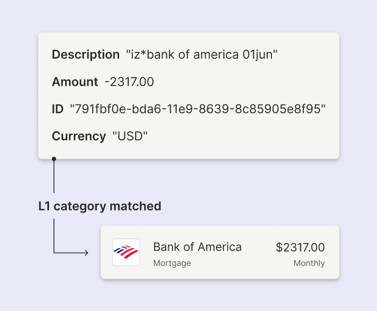
Granularity
Granularity refers to the level of detail in your data. At Bud, we have three levels of categorisation. You can think of it as a category (L1), a subcategory (L2) plus a further set of sub-categories (L3) underneath those.
Level one (L1) could, for example, be the ‘transport’ category. The second level (L2) adds more context (such as: ‘petrol and vehicle charging’), and the third (L3) is even more granular (such as: ‘electric vehicle charging’).
We only expose the L1 (category) and L2 (sub-category) to our clients for use in their apps and services. But nonetheless, the L3 category is important in identifying transactions and adding confidence to L1 and L2 categorisation.
Bud’s taxonomy has:
- 22 categories at L1
- 112 categories at L2
- over 200 categories at L3.
An example of how this works in practice is for lenders undertaking affordability assessments. Some competitors may find it difficult to identify transactions, such as a mortgage payment, with their categorisation technology alone. But Bud creates a ‘smart finder’ to identify the mortgage payment, combining categorisation, extra statistical logic, plus two extra core enrichments:
- regularity (mortgage payments typically happen once per month)
- merchant identification
This helps lenders make better informed decisions.
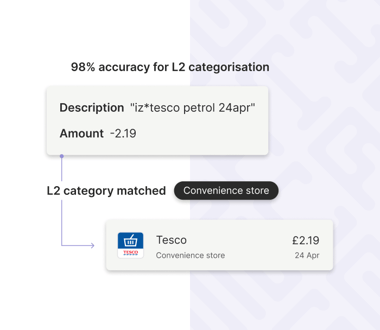
Accuracy
Bud’s market-leading AI-powered transaction categorisation is >98% accurate. Clients benefit from better data interpretation, and can build more effective money management and lending features as a result.
Bud’s accuracy is industry-leading, in part, because the technologies for transaction categorisation and merchant identification are decoupled. This provides flexibility. For example: a spend at ‘Tesco’ can map to different categories, such as ‘groceries’, ‘petrol and vehicle charging’, ‘mobile’ or ‘banking and insurance’.
But, some clients may need categorisation and merchant identification models to work together. For example, recognising a mortgage payment might involve some combination of identifying the lender as well as the amount and regularity of the payment, plus whatever we can glean from the raw transaction description. Bud’s solution facilitates this approach.
Machine-learning
Through a combination of deep learning, natural language processing, and machine learning, Bud leverages cutting edge AI to revolutionise categorisation. Bud’s language model not only considers which words appear in the data, but the order of the words and the transaction amount.
Let’s say you spend £2.19 at Tesco Petrol.
Other competitors might categorise this transaction as ‘supermarket’ (Tesco) or ‘transport’ (petrol). But the transaction amount is small, so Bud’s data intelligence platform correctly categorises this purchase as ‘convenience store’.
The other advantages of Bud’s machine-learning algorithm include:
- ongoing iterative improvements to categorisation at L3 level without service interruption (made possible because that categorisation is vital but not exposed to clients)
- behind-the-scenes experimentation to match evolving merchant technologies.
Unlike industry-standard rule-based approach, there’s no need to rely on your service provider to edit thousands of rules as each new merchant enters the market. Bud maintains the system, keeping it performant and up-to-date.
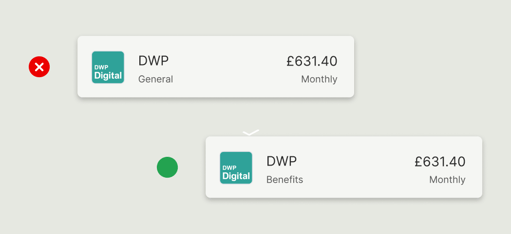
What does industry standard transaction categorisation look like?
At Bud, we’re confident that our AI-powered categorisation granularity can power pretty much any use case and, of course, we easily and iteratively add more granularity when data becomes available.
Poor categorisation granularity
The first thing to note when considering what industry standard categorisation looks like, is that not all transactions involve merchants. Salaries, benefits, rent, loan repayments, transfers to peers and more – the ability to properly categorise transactions that lack traditional ‘merchants’ through text classification is key.
Some vendors struggle with this, and the result can be a money management tool with lots of important and high value transactions categorised as ‘general’ or miscellaneous’. Elsewhere, those using transactional data to get a view of the financial position of their customer or product applicant risk making a poor decision given they don’t have the full picture.
Another limitation to traditional categorisation is the rule-based approach typically used. Their understanding of transactional data can be poor in the case where they only recognise particular or exact strings of words or patterns. This is highly susceptible to errors when raw transaction descriptions are low quality, when words are abbreviated or when there are no spaces between words.
Some competitors use MCCs (merchant category codes) to attempt to categorise transactions. These four-digit codes classify businesses according to the types of goods or services they provide. There are numerous problems with this approach – the most pertinent being that they’re not always present. Even when businesses do have these codes assigned, they can be incorrect, extremely broad or not especially consumer-friendly. In addition, only one category is associated with a merchant which doesn’t account for those businesses that do lots of things.
Likewise, combining transaction categorisation and merchant identification into a single capability is a less flexible approach. Without the consolidation of regularity and noise identification, clients will find it difficult to identify or analyse spending patterns.
With transaction categorisation and merchant identification merged into a single capability, financial institutions won’t benefit from the safety net of Bud’s double validation. A lack of understanding around transaction data means a financial institution is forced to keep their personal financial management suggestions vague and customers may look elsewhere for better services.
Unrecognised new merchants
In the financial year ending March 2022 alone, over 750,000 new UK merchants were created. Without significant effort, these would likely be unrecognisable and categorised under ‘general’, which is frustrating to customers and unhelpful for credit assessment advisors.
Even among some competitors with machine-learning based algorithms, many lack regular updates and it can be painful for clients to upgrade as technology evolves. Instead, Bud can recategorise transactions when customers provide feedback, providing flexibility in the system.
R-reliance on MCC codes
When first party data is available, it's not uncommon for most providers to settle for the simple mapping of MCC (merchant category codes, a market standard for card networks and other payment providers). Initially, MCC codes were designed with a different purpose in mind, focusing mainly on the business aspect, instead of actual customer-facing offerings. Therefore, these codes are often configured per POS (point of sale), are rarely updated and tend to be inaccurate - leading to suboptimal quality of categorisation, with incorrect codes being sent and data being underutilised.
Bud’s approach is to look at all data provided with every transaction and build models that are able to spot patterns across the whole dataset. Combined with superior AI models and the ability to quickly train for new signals, we can easily outperform any provider utilising a MCC-centric approach to categorisation.
Accurate categorisation underpins growth
If you’re a financial services company which doesn't require a high level of detail within transaction data, then industry-standard transaction categorisation might do the job for now. However, considering how things will change as you scale is an important factor.
For those who want to greatly improve customer engagement and retention, or drive cost savings and financial inclusion for lending, ultra-accurate categorisation is a must. Bud’s gold standard transaction categorisation is more likely to fulfil your needs.
But why is accurate categorisation so important?
With quality categorisation, understanding the customer becomes much easier. Bud uses it to power several high-impact products, from supporting lending decisions with Assess, supercharging digital channels with insights and money management tools available with Engage, to generativeAI-assisted customer data platform - Drive.
However, many of our clients leverage the power of categorised data directly, which we can further enrich with location information, regularity detection, subscription and income finders and more.
Summary: why Bud’s categorisation is market-leading
|
Bud’s categorisation |
What this means for you |
|
Taxonomy of over 300 categories for industry-leading accuracy. |
Improved granularity equals minimal transactions left uncategorised – heightening accuracy. |
|
L3 categorisation is constantly iterated without interruption to the service (including the ability to re-categorise based on customer feedback). |
Ensure categories remain relevant, fluid and accurate with continuous learning and re-categorisation |
|
Contextual recognition – every word has meaning and the order of words has weight. |
With complete contextualisation, categories are almost always accurately defined and updated – regardless of phrasing |
|
Transaction categorisation and merchant identification are separate capabilities. |
Bud's customisable categorisation provides enhanced power and flexibility |
Ready to find out how Bud's ultra-precise transaction categorisation can transform your business, get in contact with a member of the Bud team today.

